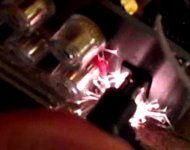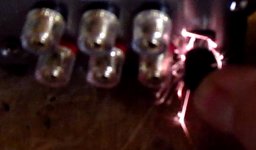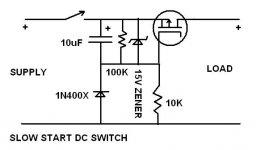I have some of these lying around, would these work?
C5: OKAYA 0.2uF 250V CAPACITORS-SPARK QUENCHERS
C5: OKAYA 0.2uF 250V CAPACITORS-SPARK QUENCHERS
sorry saturnus, Just trying to confirm the TYPE of capacitor.the recommendation was for .47uF at minimum. Thanks for letting me know max as well. my old kenwood basic C2 has a cap in that position (across the + and - input) on the AC plug, was wondering why it was there. Now I know. LEARNING!
Would these inductors be suitable replacements on the YJ blue board?
Buy Leaded Inductors Bourns 10μH 15% Leaded Inductor, 10.8A Idc, 0.006Ω Rdc Bourns 2101-V-RC online from RS for next day delivery.
I know others have recommended the HT versions of these and I was wondering if the standard versions would work just as well or whether you needed the higher temperature handling?
Buy Leaded Inductors Bourns 10μH 15% Leaded Inductor, 10.8A Idc, 0.006Ω Rdc Bourns 2101-V-RC online from RS for next day delivery.
I know others have recommended the HT versions of these and I was wondering if the standard versions would work just as well or whether you needed the higher temperature handling?
You get wet when it rains. Please see post #2445.
He doesn't plug it in like this.... we were testing to see if the cap would reduce the sparking.
How could it reduce sparking ? Please explain. Some things in electrical/electronic devices are quite simple. Any DC contact will spark. DC should better not be switched. This was once taught in technical schools.
Last edited:
I think the sparking in automobile distributor contacts result from contact bounce which happens in mechanical switches. The cap absorbs transients. It works, try it.
Back to the basics: a capacitor over contacts of a switch works like that.
In this situation you have bouncing contacts with a capacitive load....
In this situation you have bouncing contacts with a capacitive load....
3. speaking of power cords, this one sparks horribly when you connect the power cord. I know sometimes you might get a small arc when you plug in a DC power cable, but this one shoots like a 1 inch yellow spark out of the jack. None of my other class d mini amps exhibit this behaviour. It's very disconcerting and kind of scary.
I have a very simple solution. I plug the smps that powers the amp, which is connected to the amp board "permanently" (I do not disconnect it), to a cheap power bar that has a switch. Just use the power bar switch to turn on and off the amp. No need to pull any power cord. No need to solder anything. If you need to pull the amp, just unplug the AC cord from the power bar.
Also, I have a habit of turning the volume pot (be it the one on the amp board or my preamp on the second system) to minimum before I switch off the amp. So next time the amp is turned on, no tick or pop. I then start the CD player, and turn up the volume.
My 2 cents.
Regards,
I have a very simple solution. I plug the smps that powers the amp, which is connected to the amp board "permanently" (I do not disconnect it), to a cheap power bar that has a switch. Just use the power bar switch to turn on and off the amp. No need to pull any power cord. No need to solder anything. If you need to pull the amp, just unplug the AC cord from the power bar.
Also, I have a habit of turning the volume pot (be it the one on the amp board or my preamp on the second system) to minimum before I switch off the amp. So next time the amp is turned on, no tick or pop. I then start the CD player, and turn up the volume.
My 2 cents.
Regards,
Bravo !
I have a very simple solution. I plug the smps that powers the amp, which is connected to the amp board "permanently" (I do not disconnect it), to a cheap power bar that has a switch. Just use the power bar switch to turn on and off the amp. No need to pull any power cord. No need to solder anything. If you need to pull the amp, just unplug the AC cord from the power bar.
Also, I have a habit of turning the volume pot (be it the one on the amp board or my preamp on the second system) to minimum before I switch off the amp. So next time the amp is turned on, no tick or pop. I then start the CD player, and turn up the volume.
My 2 cents.
Regards,
What he said! I do the same, down to turning the volume down.
icecomponent/wurth inductor2
wurth it is!
icecomponent bass sounded louder, total mono sound more dynamic, but a friend came over to listen to "the silly little amps" so I played stereo over the two different amps, we found soundstage/image allways moved towards the speaker that was driven by the wurths inductors amp, changed wiring to pot, speakers that were driven, switched powersupplies...conclusion bass/dynamics icecomponent inductor seem better because they actually weaken soundoutput above ~200hz?, you really need to concentrate to hear soundstage/image information.
With the wurths you walk into the room with music playing and immediatly notice a huge image. Bass isn't the first thing you notice with the wurths. But if one would measure frequency respons I expect bass might actually be the same as with the icecomponents
I did listen to all icecomponent inductors left and right ch this week again. These seem to be the only inductors especially made for class d audio?, but I end up feeling they're very good for subwoofer audio, and not very good for full range audio. In my system that is🙂
wurth it is!
icecomponent bass sounded louder, total mono sound more dynamic, but a friend came over to listen to "the silly little amps" so I played stereo over the two different amps, we found soundstage/image allways moved towards the speaker that was driven by the wurths inductors amp, changed wiring to pot, speakers that were driven, switched powersupplies...conclusion bass/dynamics icecomponent inductor seem better because they actually weaken soundoutput above ~200hz?, you really need to concentrate to hear soundstage/image information.
With the wurths you walk into the room with music playing and immediatly notice a huge image. Bass isn't the first thing you notice with the wurths. But if one would measure frequency respons I expect bass might actually be the same as with the icecomponents
I did listen to all icecomponent inductors left and right ch this week again. These seem to be the only inductors especially made for class d audio?, but I end up feeling they're very good for subwoofer audio, and not very good for full range audio. In my system that is🙂
Regarding disturbing other products: My Primare cd player has very heavy chasis, inside it the cdtransport is in a seperate metalbox again, which seemed excessive to me, but if I place the sure3110pcb with ferriet beads! directly on Primare cdplayer the cd several times auto-restarts in the middle of tracks🙂 This hasn't happened once when sure3110 is moved 40cm away from Primare cdplayer🙂 nor did it happen with my 3116's, so easy fix, but it does leave me having some concerns regarding emitance using the 3116 filterless, but maybe it is a different design or it has nothing to do with filter?
Irribeo,
Which Wurth inductors were you using? I'm thinking of swapping out the stock inductors on my YJ blue board.
Which Wurth inductors were you using? I'm thinking of swapping out the stock inductors on my YJ blue board.
Regarding disturbing other products: My Primare cd player has very heavy chasis, inside it the cdtransport is in a seperate metalbox again, which seemed excessive to me, but if I place the sure3110pcb with ferriet beads! directly on Primare cdplayer the cd several times auto-restarts in the middle of tracks🙂 This hasn't happened once when sure3110 is moved 40cm away from Primare cdplayer🙂 nor did it happen with my 3116's, so easy fix, but it does leave me having some concerns regarding emitance using the 3116 filterless, but maybe it is a different design or it has nothing to do with filter?
I'll reiterate what I said above. The Sure3110 does not have any ferrite beads installed.
Indeed it has no output filter at all except for a single decoupling cap which is no good what so ever.
Last edited:
- Home
- Amplifiers
- Class D
- TPA3116D2 Amp


